| Pages:
1
2 |
aga
Forum Drunkard
    
Posts: 7030
Registered: 25-3-2014
Member Is Offline
|
|
Another Go at Making Disulphur Dichloride
Given that this is Beginnings (no references) it must be noted that:-
* Chlorine gas can kill you.
* This entire experiment was conducted in a fume hood.
* Disulphur Dichloride is highly corrosive, gives off HCl+SO2 gasses and must be stored sealed on ice.
Further to my Factice experiments it was found that Disulphur Dichloride works well, so more was required.
It can be made by reacting powdered elemental Sulphur with Chlorine gas.
The equation appears to be quite complex, yet overall it can be stated as :-
2 S + Cl2 => S2Cl2
Chlorine Gas can be produced by the oxidation of Hydrochloric acid by Potassium Permanganate.
16 HCl + 2 KMnO4 => 2 KCl + 2 MnCl2 + 8 H2O + 5 Cl2
To convert 30g of powdered sulphur, with a 20w% solution of HCl, the stoichimetry was calculated to be :-
Reagents:-
S : 30g
20w% HCl : 273 ml
KMnO4 : 30g
Products :-
Cl2 : 10.4 litres
S2Cl2: 63.2g
Previously a Cl2 scrubber was used to absorb any unreacted gas.
This seemed wasteful given the high affinity of the S to Cl2 - so much so that simple agitation of the S caused suck-back in an earlier
experiment.
To eliminate the need for a scrubber and hazardous excess Cl2 production, an anti-bump head was chosen as the reaction vessel with a rubber
glove sealed over one end with rubber bands to serve as a 'gasometer' or gas reserve (agaOmeter<sup>tm</sup> . .
In effect the system is sealed and all Cl2 produced MUST be consumed in the reaction with S to avoid pressure build-up and explosion.
A short length of rubber tube was added to the vac take-off spiggot so that Air could be flushed from the system.
As soon as a chlorine smell was detected (by an agaNose<sup>tm</sup> this tube was folded and sealed with a clothes peg (agaValve<sup>tm</sup>
this tube was folded and sealed with a clothes peg (agaValve<sup>tm</sup> . .
Practically speaking, simply regulating the rate at which HCl is added was a very effective way to regulate the rate of gas production and therefore
pressure.
The rubber glove gives a clear visual indication of the pressure in the system, and would simply blow off in the event of over-pressure, although this
would of course incur an escape of Chlorine gas.
That would be bad, yet less bad than the glass blowing apart (agaPanic<sup>tm</sup>
The addition of a large and a small magnetic stirbar to the anti-bump head caused a situation in which the normal orderly stirring becomes chaotic and
random (agaMixa<sup>tm</sup> , which is beneficial in this case as it
splashes the powdered sulphur and the liquid all over the walls of the bulb, increasing the surface area and reaction rate. , which is beneficial in this case as it
splashes the powdered sulphur and the liquid all over the walls of the bulb, increasing the surface area and reaction rate.
22 minutes into the reaction and all of the powdered sulphur was a yellow liquid.
During the reaction the liquid was measured to be 52.6 C with an infra-red thermometer.
After 1 hour 36 minutes the rate of Chlorine production appeared to be negligible, and the experiment was stopped.
The liquid contents of the reaction vessel were filtered, and 31.41g of product was recovered (the remaining solids presumably being sulphur)
representing a yield of 49.7%.
Given my own lack of experience and knowledge, i was quite pleased with almost 50% from an untested procedure.
The photographs explain it better.
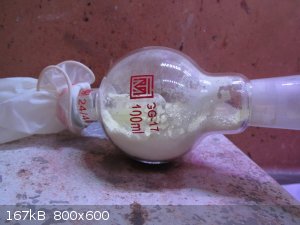 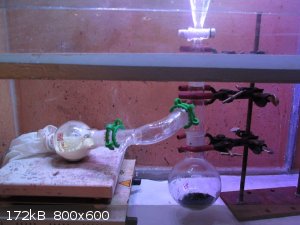 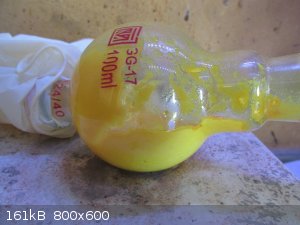 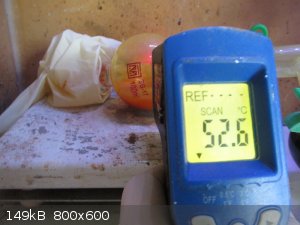 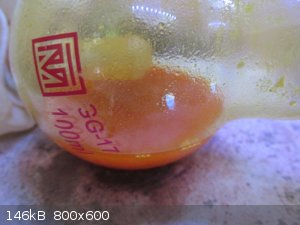 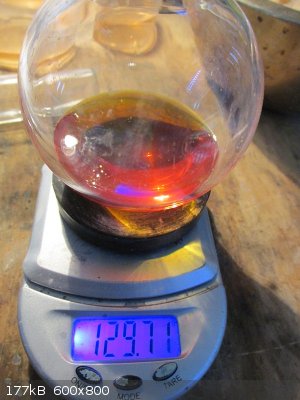
This is what a small amount of leaked S2Cl2 did to the rubber glove acting as the gas reserve:
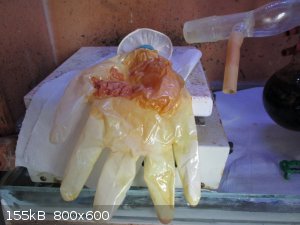
This test tube had a few drops of S2Cl2 added to water. Immediately elemental sulphur precipitated.
2 S2Cl2 + 2 H2O => SO2 + 4 HCl + 3/8 S8
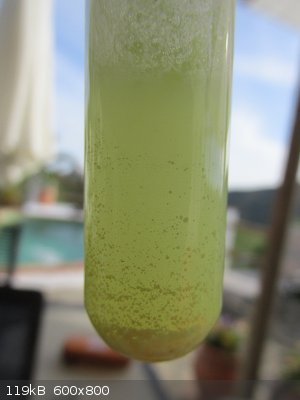
|
|
|
vmelkon
National Hazard
   
Posts: 669
Registered: 25-11-2011
Location: Canada
Member Is Offline
Mood: autoerotic asphyxiation
|
|
Looks like a fun experiment. Personally, I would not use KMnO4. I would go with that cheap pool supply stuff : Trichloroisocyanuric acid (If I got the
name right).
Signature ==== Is this my youtube page? https://www.youtube.com/watch?v=tA5PYtul5aU
We must attach the electrodes of knowledge to the nipples of ignorance and give a few good jolts.
Yes my evolutionary friends. We are all homos here. |
|
|
aga
Forum Drunkard
    
Posts: 7030
Registered: 25-3-2014
Member Is Offline
|
|
I tried it with Beach & HCl.
The bleach has a foaming agent in it which makes it a pain, and it didn't make Cl2 very fast either.
I'll see if i can get some of the pool stuff, as it did seem a waste of KMnO4.
|
|
|
blogfast25
International Hazard
    
Posts: 10562
Registered: 3-2-2008
Location: Neverland
Member Is Offline
Mood: No Mood
|
|
Are you quite sure you've got S<sub>2</sub>Cl<sub>2</sub>? Not a mixture of SCl<sub>2</sub> and
S<sub>2</sub>Cl<sub>2</sub>? Any mass balance done?
Could be a nice opportunity to determine Cl content of something, since as you love Mohr's titrations so much? 
Nice looking product though. Any plans to use for something else?
|
|
|
Magpie
lab constructor
    
Posts: 5939
Registered: 1-11-2003
Location: USA
Member Is Offline
Mood: Chemistry: the subtle science.
|
|
Yes, pool TCCA and 20% HCl (see Len1, in Prepublication) is a convenient and cheap way to produce Cl2.
I see you did not dry your Cl2. Drying would likely increase yield. But this requires more glassware which increases the potential Cl2 leak points.
I'm surprised your glove (agaOmeter) held up to the Cl2 gas.
S2Br2 is much easier to make and might work for your factice? Of, course, first you must make Br2, a liquid.
Overall, nice work!
The single most important condition for a successful synthesis is good mixing - Nicodem
|
|
|
blogfast25
International Hazard
    
Posts: 10562
Registered: 3-2-2008
Location: Neverland
Member Is Offline
Mood: No Mood
|
|
Or MnO2 + HCl. Cheaper than KMnO4.
|
|
|
Magpie
lab constructor
    
Posts: 5939
Registered: 1-11-2003
Location: USA
Member Is Offline
Mood: Chemistry: the subtle science.
|
|
Quote: Originally posted by blogfast25  | Are you quite sure you've got S<sub>2</sub>Cl<sub>2</sub>? Not a mixture of SCl<sub>2</sub> and
S<sub>2</sub>Cl<sub>2</sub>? Any mass balance done?
|
Yes, this was discussed by Sauron et al. IIRC Sauron concluded that this does not occur when making S2Br2, ie, it is the only product.
The single most important condition for a successful synthesis is good mixing - Nicodem
|
|
|
aga
Forum Drunkard
    
Posts: 7030
Registered: 25-3-2014
Member Is Offline
|
|
Quote: Originally posted by blogfast25  | Are you quite sure you've got S<sub>2</sub>Cl<sub>2</sub>? Not a mixture of SCl<sub>2</sub> and
S<sub>2</sub>Cl<sub>2</sub>? Any mass balance done?
Could be a nice opportunity to determine Cl content of something, since as you love Mohr's titrations so much? 
Nice looking product though. Any plans to use for something else? |
No idea at all of what i've got.
The first batch was massively over-chlorinated, and made veg oil go fizz.
Second batch made it solidify with no fizzing.
Judging simply by the colour this is somewhere in between.
Would a Mohr's not just show it has chlorine in it, or are you saying that the Amount of Cl2 will show the ratio of products ?
Any suggestions as to the 'what else' ?
|
|
|
aga
Forum Drunkard
    
Posts: 7030
Registered: 25-3-2014
Member Is Offline
|
|
Quote: Originally posted by Magpie  | I'm surprised your glove (agaOmeter) held up to the Cl2 gas.
S2Br2 is much easier to make and might work for your factice? Of, course, first you must make Br2, a liquid. |
These are top quality gloves from the supermarket ...
To be honest, i expected them to fall apart, yet seeing as the Product will be used for making Rubber, i reasoned that Rubber gloves might last long
enough for the process to complete, and they did.
S2Br2 sounds like it is worth a try, although i don't seem to have any Bromine compounds in my inventory.
|
|
|
j_sum1
Administrator
       
Posts: 6371
Registered: 4-10-2014
Location: At home
Member Is Offline
Mood: Most of the ducks are in a row
|
|
I want to do this. However I have no need for S2Cl2 and no desire to store it. So I guess it is off the table. Intriguing process and uncomplicated
set-up (aga's trademarked inventions aside) and a rather dramatic looking product.
I might attempt the previously discussed U-tube method though. (Number 23 on my current list of projects. I need some more time in the lab.)
|
|
|
blogfast25
International Hazard
    
Posts: 10562
Registered: 3-2-2008
Location: Neverland
Member Is Offline
Mood: No Mood
|
|
Quote: Originally posted by aga  |
Would a Mohr's not just show it has chlorine in it, or are you saying that the Amount of Cl2 will show the ratio of products ?
Any suggestions as to the 'what else' ? |
I'm just playing Devil's Advocate here. Most likely it's either pure S2Cl2 or a mixture of S2Cl2 and SCl2. But you're never certain until you analyse
it properly.
Assuming the product contains no free Cl2 (a bit of refluxing would get rid of that anyway) and only S as a second element (bar trace contaminants, of
course) then determining w% Cl would settle the question of its empirical formula from molar ratio.
[Edited on 28-4-2015 by blogfast25]
|
|
|
aga
Forum Drunkard
    
Posts: 7030
Registered: 25-3-2014
Member Is Offline
|
|
If the product scares you, dump it into water to get your powdered sulphur back, with a weak mix of HCl and H2SO3.
It isn't something i like to think is hanging around my lab, so it will get used tomorrow morning.
|
|
|
aga
Forum Drunkard
    
Posts: 7030
Registered: 25-3-2014
Member Is Offline
|
|
Right-oh. Mohr's it is then.
Refluxing in Air would destroy the product due to atmospheric moisture, and i'm out of Argon, so any free Cl2 will have to stay put.
|
|
|
blogfast25
International Hazard
    
Posts: 10562
Registered: 3-2-2008
Location: Neverland
Member Is Offline
Mood: No Mood
|
|
Quote: Originally posted by aga  | | It isn't something i like to think is hanging around my lab, so it will get used tomorrow morning. |
What if it eats your lab overnight? 
|
|
|
aga
Forum Drunkard
    
Posts: 7030
Registered: 25-3-2014
Member Is Offline
|
|
Then we can determine the Cl2 content by measuring What it ate, and How much 
A bit like a Burger Mystery and Suspense party.
[Edited on 28-4-2015 by aga]
|
|
|
blogfast25
International Hazard
    
Posts: 10562
Registered: 3-2-2008
Location: Neverland
Member Is Offline
Mood: No Mood
|
|
Quote: Originally posted by aga  |
Refluxing in Air would destroy the product due to atmospheric moisture, and i'm out of Argon, so any free Cl2 will have to stay put.
|
Does it fume in open air? [Edit: yes, it does!]
In any case, Mohr's only determines chloride, not chlorine. Unless any free chlorine present gets significantly
converted to chloride somewhere in the analytical process, no measuring error is introduced.
I note also as per Wiki that S2Cl2 is supposed to be "golden yellow" and SCl2 more "orange-red".
[Edited on 29-4-2015 by blogfast25]
|
|
|
blogfast25
International Hazard
    
Posts: 10562
Registered: 3-2-2008
Location: Neverland
Member Is Offline
Mood: No Mood
|
|
Looks like Mohr's determination of chloride won't work here because SO2 will be oxidised by chromate, the indicator used in that method. Can't see an
immediate fix for that interference... so let me ponder that for a while.
[Edited on 29-4-2015 by blogfast25]
|
|
|
Molecular Manipulations
Hazard to Others
  
Posts: 447
Registered: 17-12-2014
Location: The Garden of Eden
Member Is Offline
Mood: High on forbidden fruit
|
|
Instead of Mohr's, how about reacting a known quantity with water, filter off the sulfur and add an excess of silver nitrate to precipitate chloride.
After taking into account silver chloride's solubility product (very small) the total chlorine contant can be known. I doubt silver sulfite has a low
enough solubility to precipitate.
EDIT it's about 4.6mg/L, not much, but considering sulfur dioxide's low solubility, it shouldn't precipitate.
[Edited on 29-4-2015 by Molecular Manipulations]
-The manipulator
We are all here on earth to help others; what on earth the others are here for I don't know. -W. H. Auden
|
|
|
DJF90
International Hazard
    
Posts: 2266
Registered: 15-12-2007
Location: At the bench
Member Is Offline
Mood: No Mood
|
|
Quote: Originally posted by aga  |
After 1 hour 36 minutes the rate of Chlorine production appeared to be negligible, and the experiment was stopped.
The liquid contents of the reaction vessel were filtered, and 31.41g of product was recovered (the remaining solids presumably being sulphur)
representing a yield of 49.7%.
|
Call me old fashioned, but it is conventional to isolate products as pure as possible. I appreciate that purity may not be critical for your intended
application, but it is good practice to start as you mean to go on. Filtration may remove insoluble impurities (sulfur) but any excess chlorine (as
Cl2 or SCl2) will remain. The trick to removing this is a quick reflux over some fresh sulfur followed by distillation of the
S2Cl2.
Quote: Originally posted by aga  |
Refluxing in Air would destroy the product due to atmospheric moisture, and i'm out of Argon, so any free Cl2 will have to stay put.
|
You do not need Argon as the compound in question is not air sensitive. It is however moisture sensitive (as you note) so take precautions to exclude
moisture - drying glass in the oven at 110 *C and assembling hot with a CaCl2 drying tube in place should suffice. As others have
mentioned, your (lower than expected) yield is likely a consequence of the lack of dryig train between the Cl2 generator and the reaction
mixture.
[Edited on 29-4-2015 by DJF90]
|
|
|
aga
Forum Drunkard
    
Posts: 7030
Registered: 25-3-2014
Member Is Offline
|
|
Quote: Originally posted by Molecular Manipulations  | Instead of Mohr's, how about reacting a known quantity with water, filter off the sulfur and add an excess of silver nitrate to precipitate chloride.
After taking into account silver chloride's solubility product (very small) the total chlorine contant can be known. I doubt silver sulfite has a low
enough solubility to precipitate.
EDIT it's about 4.6mg/L, not much, but considering sulfur dioxide's low solubility, it shouldn't precipitate.
[Edited on 29-4-2015 by Molecular Manipulations] |
How about taking a known qty of the product, react with a larger volume of water, centrifuge to get the S to the bottom, then drip a known conc of
silver nitrate into the same container with a burette until it stops forming a white precipitate ?
My only worry about adding water & filtering is that i only have 31g of the product and would rather not use all of it overcoming losses due to
filtering.
|
|
|
CuReUS
National Hazard
   
Posts: 928
Registered: 9-9-2014
Member Is Offline
Mood: No Mood
|
|
S2Cl2 can be used in place of PCl3 or SOCl2 to convert alcohols and carboxylic acids to alkyl chlorides
and acyl chlorides respectively
http://chemistry.mdma.ch/hiveboard/chemistrydiscourse/000216...
btw why don't you try to make it in-situ ? that might prevent formation of SCl2
see this
| Quote: | Another similar synthesis, generating sulfur chloride in situ:
Mix quickly and thoroughly 205-215 g of pulverized fine NaOAc and 10g dry sulfur powder, the mixture is quickly transferred to a wide-mouth 1 liter
RBF and wetted w/25 ml acetic anhydride. Into the flask through the rubber cork extend 1) a wide tube for chlorine in-flow........
|
https://erowid.org/archive/rhodium/chemistry/anhydrides.html
found two very good write-ups as well 
read the 6th post by antoncho and 8th post by catastrope
http://chemistry.mdma.ch/hiveboard/novel/000207554.html
[Edited on 29-4-2015 by CuReUS]
|
|
|
Magpie
lab constructor
    
Posts: 5939
Registered: 1-11-2003
Location: USA
Member Is Offline
Mood: Chemistry: the subtle science.
|
|
Quote: Originally posted by CuReUS  | S2Cl2 can be used in place of PCl3 or SOCl2 to convert alcohols and carboxylic acids to alkyl chlorides
and acyl chlorides respectively
|
That's a very useful thing to know as PCl3 and SOCl2 are more difficult to produce.
But I don't think aga is after an anhydride.
Wiki shows how the S2Cl2 can be purified by distillation, or, apparently by just letting it sit and auto-convert from SCl2.
To determine purity, why not use the standard technique: determine the boiling point.
The single most important condition for a successful synthesis is good mixing - Nicodem
|
|
|
aga
Forum Drunkard
    
Posts: 7030
Registered: 25-3-2014
Member Is Offline
|
|
As far as i can work out, the two possible reactions with water both end up simplified to leave the interesting species as :-
2 SxCl2 + 2 H2O => 4 HCl + SO2
To me this means that regardless of the ratio of SCl2 to S2Cl2 the products are
4 HCl + SO2 giving HCl and H2SO3
If that's right so far, then would not a simple titration of the acids with NaOH give the total acid molarity, of which the HCl component would be
4/5ths of that total, from which the Cl2 can be calculated ?
I just tried adding known [M] of AgNO3 and you can't see anything as the mix is too murky.
At 17.2ml black precipitate became visible.
With that as the endpoint the mm calculates out at 197.5 g/mol, which is 146% out of range.
|
|
|
aga
Forum Drunkard
    
Posts: 7030
Registered: 25-3-2014
Member Is Offline
|
|
Oh !
You mean zap out all the silver chloride, capture it, dry it and weight it !
OK. I can still do that with my failed attempt as i've not thrown the stuff away yet.
|
|
|
blogfast25
International Hazard
    
Posts: 10562
Registered: 3-2-2008
Location: Neverland
Member Is Offline
Mood: No Mood
|
|
Quote: Originally posted by aga  | [How about taking a known qty of the product, react with a larger volume of water, centrifuge to get the S to the bottom, then drip a known conc of
silver nitrate into the same container with a burette until it stops forming a white precipitate ?
My only worry about adding water & filtering is that i only have 31g of the product and would rather not use all of it overcoming losses due to
filtering. |
You would never see the end-point, trust me. You need the chromate indicator to see when all chloride has been converted to AgCl. Then the chromate
forms red Ag<sub>2</sub>CrO<sub>4</sub>.
I've found the simplest of fixes to the sulphite/chromate problem. Mohr's titration requires slightly alkaline conditions. Adding a pre-determined
amount of hydrogen peroxide will oxidise the sulphite to sulphate but in alkaline condition hydrogen peroxide cannot oxidise chloride to chlorine
(only in acidic conditions does this happen). Sulphate does not interfere because it's far more soluble than AgCl (personal experience confirms that).
For 250 ml of analyte solution only about 1.7 g of your product is needed. And that affords as many titrations as your heart
contends! 
Now it's your call. If you want to proceed, I'll do the calcs for you.
[Edited on 29-4-2015 by blogfast25]
|
|
|
| Pages:
1
2 |